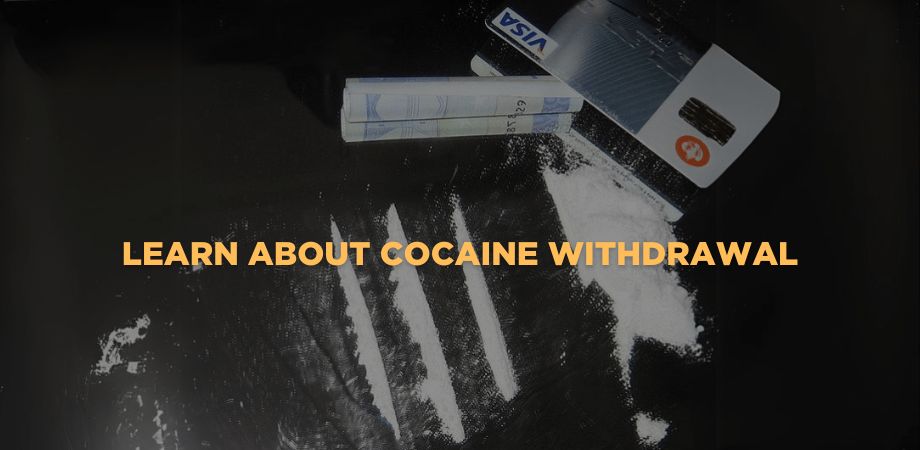Cocaine withdrawal is a set of body and brain reactions that happens after someone with cocaine dependence or substance use disorder (SUD) stops using cocaine or uses much less. Doctors describe this as cocaine withdrawal syndrome.
The main causes of cocaine withdrawal are stopping cocaine use abruptly, body tolerance, and brain chemical changes. Cocaine blocks the brain from making dopamine, a neurotransmitter that plays a key role in feelings of pleasure and reward. When one stops using cocaine, the brain doesn’t have enough dopamine, causing withdrawal symptoms in the central nervous system (CNS).
The common symptoms of cocaine withdrawal include intense cravings for cocaine, fatigue, depression, anxiety, irritability, agitation, sleepiness, overeating, and extreme suspicion and paranoia.
The withdrawal timeline of cocaine withdrawal starts 30 minutes to 4 hours after the last use, gets worse on days 1-3 with bad depression and fatigue, gets better over 1-4 weeks, but cravings last 1-6 months.
The diagnosis of cocaine withdrawal needs cocaine detox, which includes doctor visits, questions about drug use, and tests by addiction specialists at treatment centres such as rehab centres in India.
The common treatment methods include cocaine detox, inpatient treatment programs, outpatient treatment programs, medications like antidepressants and Benzodiazepines, counselling, and support groups like Cocaine Anonymous.
The main risk factors of untreated withdrawal include complications like severe depression, relapse, overdose after relapse, cocaine induced psychosis, and mental health problems.
The prevention strategies for withdrawal include doctors’ help, slowly using less cocaine, cocaine detox programs like cognitive behavioural therapy, support groups like Narcotics Anonymous, and avoiding triggers.
What Is Cocaine Withdrawal?
Cocaine withdrawal is a group of body and brain reactions that happen when someone who uses cocaine regularly stops using it. As a stimulant drug, the DSM-5 puts cocaine under stimulant withdrawal. The ICD-10 gives it the code F14.23 to identify cocaine withdrawal syndrome in medical records.
Cocaine withdrawal occurs due to physical dependence, where the body needs cocaine to function normally, and psychological dependence, where the mind craves cocaine. When cocaine use stops, dopamine levels drop in the brain, causing withdrawal symptoms like depression, fatigue, and intense cravings that can last 1 week+.
What is the Difference Between Cocaine Withdrawal and Cocaine Detox?
The main difference between cocaine withdrawal and cocaine detox is that cocaine withdrawal is the body’s natural reaction when stopping cocaine. In contrast, cocaine detox is the medical process of safely managing those body reactions.
Cocaine withdrawal happens 30 minutes after someone with cocaine dependence stops using the drug, causing symptoms like depression, cravings, and fatigue.
Cocaine withdrawal is dangerous if left unmanaged, as severe depression and intense cravings lead to relapse or self-harm, hence the need for cocaine detox. Cocaine detox is supervised medical care where psychologists, doctors, and nurses safely manage cocaine withdrawal symptoms.
The following table highlights the main differences between cocaine withdrawal and cocaine detox.
|
Cocaine Withdrawal |
Cocaine Detox |
|
The body and brain’s reaction to stopping cocaine |
It’s a safe medical process of managing the body’s and brain’s reactions after stopping cocaine |
|
Happens automatically (30 minutes) after the last dose of cocaine |
Requires medical supervision and planning |
|
Symptoms include depression, cravings, and fatigue |
Use medications such as antidepressants and cognitive behavioural therapy to reduce symptoms |
|
It’s dangerous without medical care, family support, or support groups |
It’s safe with medical monitoring |
|
Lasts 1-4 weeks naturally |
Takes 7-10 days with medical help |
|
High risk of relapse and suicidal thoughts if no supervised management |
Lower risk of relapse and suicidal thoughts with professional help |
What are the Causes of Cocaine Withdrawal?
The main causes of cocaine withdrawal are:
- Stopping cocaine use abruptly
- Developing tolerance
- Brain chemical changes
The main causes of cocaine withdrawal are explained below.
- Stopping cocaine use abruptly is when one suddenly quits using cocaine after taking it regularly. The body and brain expect the cocaine. When it’s suddenly gone, the body and the brain react with withdrawal symptoms such as depression or sleepiness.
- Developing tolerance is the brain and body getting used to cocaine. One needs cocaine to feel the same effect. Cocaine tolerance happens with small, moderate, or heavy use. When one stops using cocaine, the brain and the body are dependent on it, and withdrawal starts.
- Brain chemical changes occur when cocaine blocks the removal of dopamine (a neurotransmitter that plays a key role in feeling good), tricking the brain into relying on cocaine instead. These chemicals fluctuate naturally. When cocaine is present, the brain produces less dopamine, and when cocaine stops, dopamine levels drop too low, leading to fatigue, sadness, and intense cravings.
What Are the Symptoms of Cocaine Withdrawal?
The common symptoms of cocaine withdrawal are intense cravings for cocaine, fatigue, depression, anxiety, irritability, agitation, sleepiness, extreme suspicion, paranoia, headaches, increased appetite, migraines, insomnia, muscle aches and pain, shaking and tremors, sweating, chills, and hypersomnia.
The cocaine withdrawal symptoms happen when someone with cocaine dependence stops using cocaine, and the central nervous system (CNS) becomes overactive without the cocaine calming effect.
These cocaine withdrawal symptoms are put into physical and psychological categories.
Physical Symptoms of Cocaine Withdrawal?
The physical cocaine withdrawal symptoms are:
- Fatigue
- Headaches
- Migraines
- Muscle aches and pain
- Shaking and tremors
- Sweating
- Chills
- Hypersomnia
- Insomnia
- Increased appetite
Psychological Symptoms of Cocaine Withdrawal
The psychological cocaine withdrawal symptoms are:
- Depression
- Anxiety
- Irritability
- Agitation
- Intense cravings
- Paranoia
- Extreme suspicion
- Psychosis
- Delusions
- Mood swings
- Trouble thinking clearly
- Anhedonia
The Diagnostic and Statistical Manual of Mental Disorders, 5th edition, text revision (DSM-5-TR) classifies physical and psychological cocaine symptoms as mild, moderate, or severe, based on the number of symptoms present within a given period.
Mild Cocaine Withdrawal Symptoms
The mild cocaine withdrawal symptoms start 30 minutes to 4 hours after the last cocaine use.
The mild symptoms of cocaine withdrawal are:
- Fatigue
- Headaches
- Mild anxiety
- Carvings
- Trouble sleeping
- Increased appetite
The mild cocaine symptoms are explained below.
- Fatigue is a feeling of extreme tiredness and lack of energy, often experienced after staying awake for an extended period.
- Headaches are a type of pain in the head that feels like pressure or throbbing.
- Mild anxiety is feeling worried or nervous about things without an apparent reason.
- Irritability is characterised by becoming easily angry or annoyed at small things.
- Cravings are intensely wanting for cocaine that feels hard to control.
- Trouble sleeping is having a hard time falling asleep or staying asleep through the night.
- Increased appetite is feeling hungry more often and wanting to eat more food.
Moderate Cocaine Withdrawal Symptoms
Moderate Cocaine withdrawal symptoms occur 1-3 days after the last cocaine use.
The moderate cocaine withdrawal symptoms are:
- Depression
- Strong fatigue
- Migraines
- Muscle aches and pain
- Agitation
- Mood swings
- Strong cravings
- Hypersomnia
- Anhedonia
The moderate cocaine withdrawal symptoms are explained below.
- Depression is feeling sad, hopeless, and empty because dopamine (a feel-good chemical) levels are low.
- String fatigue is a state of extreme tiredness, where even simple tasks feel impossible to accomplish.
- Migraines are severe headaches characterised by sharp pain that can cause nausea and vomiting.
- Muscle aches and pain are sore muscles all over the body, similar to those experienced after strenuous exercise.
- Agitation is feeling restless and unable to sit still or stay calm.
- Mood swings are sudden mood changes, ranging from feeling okay to feeling angry or sad.
- Anhedonia is the inability to experience pleasure or happiness from things that used to be enjoyable.
- Hypersomnia is sleeping too much, sometimes 12-15 hours per day.
Severe Cocaine Withdrawal Symptoms
The severe cocaine withdrawal symptoms peak 3-5 days after the last cocaine use.
The severe cocaine withdrawal symptoms are:
- Severe depression
- Delusions
- Extreme fatigue
- Severe muscle pain
- Insomnia
- Suicidal thoughts
- Intense cravings
- Paranoia
- Psychosis
The severe withdrawal cocaine symptoms are explained below.
- Paranoia is the perception of things that are not real, whether seen, heard, or felt.
- Delusions are the persistent belief in things that are not true, despite evidence to the contrary, and a refusal to change one’s mind.
- Insomnia is not being able to sleep for days, making other symptoms worse.
- Suicidal thoughts are thinking about hitting or killing yourself because of severe depression.
What Are the Early Signs of Cocaine Withdrawal?
The early signs of cocaine withdrawal appear within 30 minutes to 4 hours after the last cocaine dose.
The early signs of cocaine withdrawal are:
- Fatigue
- Craving for cocaine
- Anxiety
- Irritability
- Headaches
- Trouble sleeping
- Increased appetite
- Mood changes
- Restlessness
- Depression
How Long Does Cocaine Withdrawal Last?
Cocaine withdrawal lasts for 1-4 weeks for most symptoms, like anxiety, irritability, and fatigue, but cravings continue for 1-6 months.
The withdrawal cocaine timeline starts 30 minutes to 4 hours after the last use, gets worse on days 1-3 with bad depression and fatigue, then gets better over 1-4 weeks. However, post-acute withdrawal syndrome (PAWS) lasts 1-6 months after the last cocaine use, with ongoing cravings.
The cocaine withdrawal timeline has different stages that peak at different times and then improve slowly.
The cocaine withdrawal timeline stages are:
- Early Stage: it starts 30 minutes to 4 hours with symptoms including fatigue, cravings, anxiety, and irritability, which begin after cocaine wears off.
- Peak Stage: It starts 24 to 72 hours (1-3 days) with symptoms such as depression, intense cravings, agitation, and mood swings, which are at their worst during this time.
- Recovery Stage: It spans 1-4 weeks with symptoms such as fatigue, depression, and cravings starting to become less severe.
- PAWS Stage: Spans 1-6 months, where symptoms such as long-time cravings, mild depression, and sleep problems continue after cocaine use stops.
The following table shows the cocaine withdrawal timeline with each stage, how long it lasts, and the symptoms.
|
Stage |
Timeline |
Symptoms |
|
Early Stage |
30 minutes to 4 hours after the last cocaine dose |
Fatigue, cravings, anxiety, irritability, headaches |
|
Peak Stage |
24-72 hours (1-3 days) after previous cocaine use |
Severe depression, intense cravings, agitation, mood swings, paranoia |
|
Recovery Stage |
1-4 weeks after the last dose |
Fatigue, depression, cravings, and sleep problems start to improve |
|
Post-Acute Withdrawal Syndrome (PAWS) Stage |
1-6 months after last use |
Long-term cravings, mild depression, anxiety, and sleep problems |
How Do Doctors Diagnose Cocaine Withdrawal?
Doctors diagnose cocaine withdrawal through clinical assessment, medical history review, and physical examination using DSM-5 and ICD-20 criteria.
The diagnosis of cocaine withdrawal needs cocaine detox evaluation, which includes doctor visits, questions about drug use, and tests by addiction specialists at treatment centres, such as rehabilitation centres in India.
Doctors must be careful about misdiagnosis risks because cocaine symptoms look like other mental problems, like depression or anxiety disorders.
The diagnostic tools and steps for cocaine withdrawal are:
- Medical history check
- Physical exam
- DSM-5 criteria
- ICD-10 classification
- Urine toxicology test
- Cardiovascular exam
- Mental health assessment
The diagnostic tools and steps for cocaine withdrawal are explained below.
- Medical History Check: Medical history is when doctors ask about your past drug use and health problems. The question helps doctors understand how much one uses, how often, and for how long to predict the severity of withdrawal.
- Physical Exam: A physical exam is when doctors check your body to assess your heart rate and blood pressure by touching or listening. Cocaine makes your heart beat faster, which causes heart problems.
- DSM-5 Criteria: DSM-5 is a big book listing symptoms for every mental illness and addiction. Doctors use this to ensure someone really has cocaine withdrawal and not just feeling sick from something else.
- ICD-10 Classification: The ICD-10 is a numerical system used by doctors to categorise every disease in the world. The code F14-23 is specifically for cocaine withdrawal, and doctors use it to write it down in medical records.
- Urine Toxicology Test: Urine toxicology tests are lab tests that find the presence of cocaine in your urine.
- Cardiovascular Exam: A cardiovascular exam is a procedure in which doctors assess the function of your heart and blood vessels. Cocaine damages the heart and blood vessels, so doctors test reflexes, memory, and thinking to see if the cocaine hurts the brain.
- Mental Health Assessment: A Mental health assessment is when doctors ask questions about your thoughts and feelings. For cocaine withdrawal, addiction specialists look for depression, anxiety, and suicidal thoughts.
What Are the Treatment Options for Cocaine Withdrawal?
The treatment options for cocaine withdrawal are medical detox, medications, inpatient treatment programs, outpatient treatment programs, cognitive behavioural therapy, and support groups.
The treatment options for cocaine withdrawal are explained below.
Medical Detox
Medical detox is the first step, where doctors watch a patient 24/7 at drug addiction treatment centres, such as rehab centres, with medical staff who understand substance use disorder.
Medications
Medications are drugs doctors give you to help with withdrawal symptoms and cravings for cocaine. When there are no medications currently existing to manage stimulant withdrawal effectively, doctors give you medications to manage the withdrawal symptoms to keep you comfortable during early recovery.
Benzodiazepines are best for anxiety during cocaine withdrawal, because they calm your nervous system quickly.
Antidepressants are administered to help with depression as they help the brain fix the dopamine chemical balance caused by cocaine.
Modafinil is given to help with cocaine cravings, which safely works on the same brain areas as cocaine but is safer.
No safe home remedies exist for cocaine withdrawal. Medical supervision is required because stopping cocaine causes dangerous depression and suicidal thoughts.
Outpatient Treatment Program
Outpatient treatment for cocaine withdrawal means you get de-addiction therapy and counselling during the day, but sleep at home.
Inpatient Treatment Program
An inpatient treatment program means you live at a treatment centre, e.g., a hospital, where doctors, nurses, and therapists take care of you full-time as they teach you how to live without cocaine use.
Cognitive Behavioural Therapy (CBT)
Cognitive behavioural therapy is a type of therapy where you learn new ways to think and act without using cocaine.
Support Groups
Support groups are meetings where you talk with other people who have also stopped or are trying to stop using drugs, such as Narcotics Anonymous (NA).
What Are the Risks of Untreated Cocaine Withdrawal?
The common risks of untreated cocaine withdrawal are listed below.
- Relapse risk is going back to using cocaine after trying to stop. A study by Substance Use and Addiction suggests that about 50% of people using stimulants like cocaine relapse within the first year, with 24% returning to weekly cocaine use.
- Co-occurring disorders are mental health problems that happen at the same time, like depression, anxiety, and bipolar disorder.
- Overdose risk is when you take too much cocaine. According to the National Centre for Drug Abuse Statistics (NCDAS) and CDC, 1 in 5 drug overdose deaths in 2023 were cocaine related, with nearly 30,000 cocaine deaths.
- Cardiovascular complications mean serious heart and blood vessel problems, like heart attacks, strokes, and other life-threatening conditions. Cocaine damages the heart and blood vessels, and quitting without medical help can make these heart problems worse.
- Suicidal risk means having thoughts of hurting or killing yourself, and sometimes these thoughts feel uncontrollable. Using cocaine makes the risk of suicide up to 16 times higher. Without proper support, a person can feel hopeless, which may lead them to harm themselves.
Ignoring cocaine withdrawal treatment makes the risks much worse. With cocaine detox, a person gets help to manage cravings, balance brain chemistry, and stay safe while going through withdrawal.
How to Prevent Cocaine Withdrawal?
To prevent cocaine withdrawal, consider medical supervision and early intervention strategies that reduce withdrawal symptoms and support recovery.
Here are cocaine withdrawal prevention strategies that focus on early intervention and medical support.
- Early intervention is starting cocaine withdrawal treatment before withdrawal symptoms become severe.
- Education and awareness are learning about cocaine addiction and withdrawal through classes and counselling. You’ll understand how cocaine affects your brain and help you prepare for recovery challenges.
- Access to rehab centres involves visiting treatment facilities that provide 24-hour medical drug addiction care during withdrawal.
- Support groups are group meetings with other people recovering from cocaine addiction. Support groups such as Cocaine Anonymous provide emotional support and practical advice during difficult withdrawal periods.
- A family support system is family members supporting you during your recovery plan through family therapy sessions.
- Relapse prevention is learning coping skills that help avoid triggers that cause cocaine cravings.
- Medical supervision involves visiting doctors, psychiatrists, or addiction specialists as soon as you stop using cocaine. They’ll monitor your body and give you safe medicines that reduce withdrawal symptoms like depression and fatigue.
What is the Difference Between Cocaine Dependence and Cocaine Addiction?
The difference between cocaine dependence and cocaine addiction is that cocaine dependence is when your body and brain get used to cocaine and need it to function normally. In contrast, cocaine addiction is using too much cocaine and being unable to stop using it even when it hurts your health, school, work, or family. Addiction is about losing control and always looking for the drug.
The signs and symptoms of cocaine dependence include;
- Intense cravings or urge to use cocaine
- Spending a lot of time getting and using canned cocaine
- Not able to cut down or stop using cocaine, even when you want to
- Using cocaine even when it hurts your health, school, work, or family
- Losing interest in your hobbies or activities you once enjoyed because you’re taking that time to indulge in cocaine
- Thinking about cocaine all the time
- Needing more cocaine to feel the same effect (tolerance)
- Feeling sick, sad, or tired when not using cocaine (withdrawal)
What is the Difference Between Cocaine Withdrawal and Cocaine Overdose?
The main difference between cocaine withdrawal and cocaine overdose is that cocaine withdrawal comes from stopping cocaine use, while cocaine overdose comes from taking too much cocaine.
Cocaine withdrawal happens when you stop using cocaine after using it often. The body reacts with sadness, sleep problems, and intense cravings because your brain is missing cocaine.
Cocaine overdose, also known as cocaine poisoning, happens when you take too much cocaine at once. The body can’t handle the excess cocaine, which causes chest pain, stroke, seizures, or even death.





